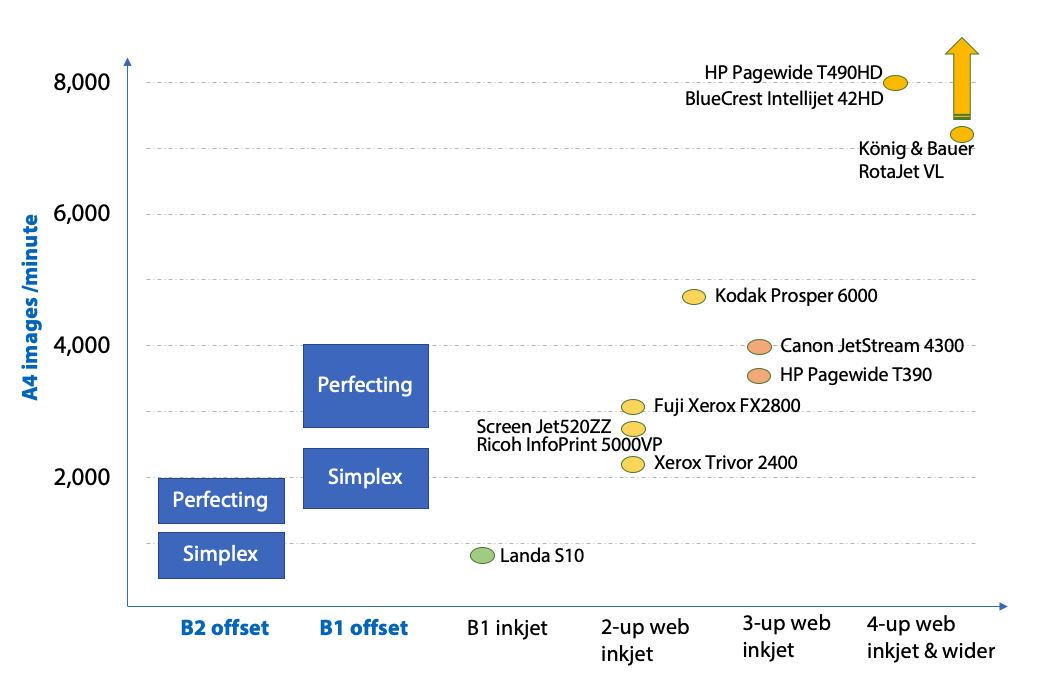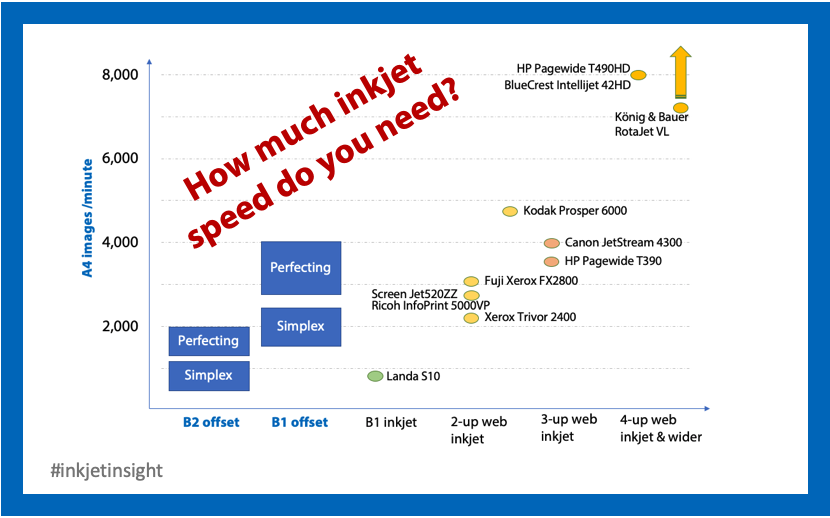Digital printing is for short runs – that is the common wisdom. There are exceptions to that rule, for example when it comes to high volume variable data jobs in transaction printing and direct mail. Also, for static jobs digital print, especially inkjet, is pushing the boundaries towards longer runs.
There are numerous at ultra-high-volume inkjet solutions available today. On the sheet-fed side the Landa S10 currently provides the highest output with 6,500 B1 simplex sheets/hour, which would be about 870 A4 images per minute. Landa plans to double the speed to 13,000 sheets/hour, but that has not arrived yet. Other sheetfed inkjet solutions are much slower – maxing at a bit over 300 A4 images/minute. Even the speed of the S10 pales in comparison to continuous inkjet.
Web-fed inkjet is far outpaces sheet-fed in throughput. Top speed models are reaching 200 m/min (650 feet/min) web speed, with the Kodak Prosper 6000, HP T490/Bluecrest IntelliJet 42HD and König & Bauer RotaJet even reaching about 300 m/min. The main differentiator in terms of page output is the web width. A 4-up web press can print twice the amount of pages than a 2-up press at the same web speed.
There is plenty of choice in 2-up inkjet web presses in different speed tiers. Among the fastest color 2-up inkjet presses are the Kodak Prosper 6000 at close to 5,000 A4 images/min followed by the Fuji Xerox FX2800, Screen TruePress 520ZZ / Ricoh InfoPrint 5000 VP (no longer marketed) and the Xerox Trivor 2400. Note that the Prosper 6000 has a slightly wider web and prints in landscape mode, which increases throughput.
Similar web speed on 3-up presses gives about 50% higher throughput over a standard 2-up presses with the Canon JetStream 4300 and the HP T390 as top speed models – reaching up to 4,000 A4 images/min. Some of the 4-up models reach the highest web speeds and the additional width makes them the most productive inkjet presses. The HP T490HD / Bluecrest IntelliJet 42HD reaches about 8,000 images per minute in performance mode. The RotaJet has a bit lower web speed, but even 6-up presses are possible, which could give a full-blown model even higher page output.
Will I get that speed?
Inkjet presses are usually designed to reach and maintain their rated speed. However, they might need to run slower when printing at the highest resolution. Some presses print at a lower resolution in web direction (or both directions) at full speed. How much detail and density is lost in this case should be checked for each application (depending on paper and image). The differences might be small but need to be checked against the desired output quality.
Also, high ink coverage and certain substrates (heavy or gloss coated) can require the press to slow down to avoid humidity build-up in the press. As a workaround some presses have the option for extra drying power, or a different drying configuration to keep up the press speed.
Do I need that speed?
As mentioned, there are long run jobs where a lot of productivity comes in handy. There might be tight deadlines as well, which requires top productivity in a short period of time.
There are more considerations to speed. Usually with higher speed and larger format the cost-per-page goes down. The cost of a faster device, footprint, overhead and the like tends to increase slower than the productivity. In other words, doubling speed for less than doubling the costs. Another very important variable is staffing. One faster press usually requires less staffing than two presses at half the speed combined. This was a major contributor for the move to larger format offset presses. In inkjet this is somewhat less pronounced as more is automated (especially the change-over) and less staff is needed in general.
There are also some arguments against top productivity presses. The pressure to keep a very productive busy is very high. For some companies, it makes more economic sense to start small and increase the inkjet capacity incrementally. Finishing restraints can be important as well for wider webs and larger sheets. Some companies prefer the redundancy and flexibility of two slower presses over a single high speed device.
What does the market say
As an analyst I expected to see more 3 and 4-up web installations after they became available. This did not materialise. There are buyers for the wide presses but, compared to the 2-up presses, the installed share is in the single % range. The limited choice for these presses did not help either.
Many users do not need and aren’t economically viable at the highest volumes. Also, shops switching from 2-up roll-fed toner devices usually do not want to change their finishing set-up. Still with more book and commercial printers investing in inkjet the demand for wider and more productive presses should have gone up more than it has. It seems that a good portion of the high-volume users still prefer 2-up for the easier handling of substrates and finishing and for the back-up multiple presses offers. Also, the automation of inkjet presses is already high, so this cost saving potential in staff is lower comparing inkjet options to each other rather than to other technologies. Other applications such as inkjet printed newspapers, magazines and catalogues which were expected to require more high-productivity wide web press installations invested to only a small degree or not at all. I do expect more magazine and catalogue inkjet printing in the future, but this will take more time. There are a number of considerations, including postal processing, that make the European market more suitable for inkjet printed magazine and catalogue printing than the U.S. market.
Benchmarking against offset
Offset printing is known as a high-speed reproduction process. There are many tiers of productivity available.
Sheetfed offset productivity is very much dependent on the press format. There are differences in the press speeds between vendors and model lines, with top speeds usually in the 15,000 to 18,000 sheets per hour range. The influence of the format is bigger however. When moving from B2 to B1 format the output essentially doubles when maintaining the same sheet/hour speed.
In reality, the max press speed is not always reached. Paper types, motifs and paper conditions can restrict the speed. Two sided printing (perfecting) can slow the press down. Also during make-ready and start-up the press speed is usually ramped up. Even disregarding the standstill during the makeready it is common that presses do not reach full speed.
Webfed offset presses run at much higher speeds. Even a “modest” 16 page web runs at more than 20,000 A4 impression equivalent per minute. However, press sales collapsed in the last 10 years. Most presses sold since 2000 had larger formats though – multiplying the output. At the same time, high volume applications in catalogues, newspapers, magazines and inserts are shrinking, limiting the market opportunity and causing a lot of consolidation in the web offset business.
The chart below summarises the speed of different presses for a quick comparison. Webfed inkjet presses are on par or surpass sheetfed offset already.
A limited selection of inkjet presses is listed with their highest (nominal) speed. The A4 ipm equivalent is based on duplex lines. The exact number for web-fed models depends on the gap between the pages, so slight deviations from other stated data can occur. The König & Bauer RotaJet is a bit of an outlier as it has options for going very wide, which would increase the throughput even more. Offset presses are shown as a range, as press speeds differ by model and for short runs presses typically do not reach full rated speed. Straight presses tend to run faster than perfecting presses.

Moving forward
Production inkjet has achieved a high level of productivity in a wide array of application areas already. Top speed, roll-fed inkjet easily outpaces sheetfed offset in terms of images printed. With the market moving towards shorter runs there is only limited need to go a lot faster – if it is not improving the cost base of inkjet considerably. Inkjet in production print is just at the start of its technology lifecycle and progress can and will be made in many areas.
However, I would expect to see some faster 2-up presses for those needing higher productivity and incrementally improving the cost base. The story is different for sheet-fed inkjet, where some speed improvements should be welcome, as not all applications can be efficiently produced on webfed devices. Considering that inkjet excels in short runs it may never be necessary to reach full offset speed but more productivity in a cost-effective package would certainly enlarge the application range.


Comments
The finishing can often be the limiting factor, especially in a diverse environment, were various types of products are produced.
Michael – that’s true. I’ve spoken with many companies who had chosen inline finishing on their first inkjet device and then chose to move it offline when they upgraded or added presses. It’s very expensive to lose press time because of finishing jams or maintenance.